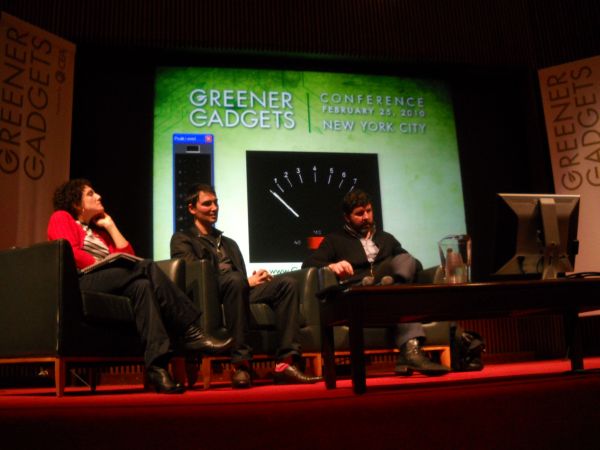Greener Gadgets 2010: The race to make things out of better things
When you buy a PC or some other CE gadget, what kinds of substances are actually inside it...and what's being used to ship it to your house? At the Consumer Electronics Association's Greener Gadgets 2010 in New York City last week, ecologically oriented speakers touched on that question, in some cases proposing alternative materials -- such as cork or "Ecocradle" -- that they'd like to see show up in those places instead.
Yves Behar, founder of the Fuseproject product design agency, held forth on how gadgets can be "desirable" and "in demand" while at the same time friendly to the environment.
As a few examples of this combination of traits, Behar cited Herman Miller's energy-efficient LED lights, Bluetooth headphones from Jawbone, and PCs that he personally helped to design earlier in his career for the One Laptop Per Child (OLPC) project.
But what's actually inside the "typical laptop" PC? Leo Bonanni, founder of Sourcemap.org, provided his answer by pointing to a slide of one of the many "sourcemaps" created by the open source group to illustrate the supply chain origins and carbon footprints of various objects.
Bonanni's sourcemap of the typical laptop includes about 50 ingredients, including steel from the Russian Federation, copper from Chile, nickel from Australia, and glass from Kentucky, along with aluminum, cadmium, and lead. The latter two ingredients often end up being often reused in children's jewelry, he noted. "We only have something for a short time in its life," according to Bonanni, who is also a PhD. candidate at MIT Media Lab. "We're just kind of shepherding it from one point to another."

Pictured left to right: Sarah Rich, senior editor, Dwell; Julian Lwin, owner, Lwindesign; and Andrew Wagner, editor-in-chief, ReadyMade, participating in the Greener Gadgets conference in New York City last February 25. [Photo credit: Jacqueline Emigh]
Through the information in the sourcemaps about carbon footprints, "You can say, 'We are exactly this green.'"
Aside from the laptop map, other popular sourcemaps on the .org site include maps for a toothbrush, a bottle of Poland Springs water, a Tesla Roadster, a Toyota Prius, and a giant TCR '04 bicycle.
Bonanni didn't precisely say whether he believes the materials in a "typical laptop" are environmentally sound. But Adele Peters, a participant in this year's Greener Gadgets design contest, clearly thinks she's come up with a better alternative to the computer mouse that ships in the same box as so many desktop PCs.
Peters' entry in the contest, Corky, is a wireless mouse designed to be powered by the motion of your hand, thereby eliminating the need for batteries. Corky's shell is made of cork recycled from bottlecaps, whereas its other components come from recycled plastic.

"Movement back and forth on the desk is captured by elements within the mouse shell. Buttons on the left and right each engage a piezoelectric element which stores the energy generated. The scroll wheel actuates another element as it turns," according to literature posted on the Green Gadgets site.
Corky made it onto a list of ten finalists culled from visitors' votes on the Web site. But in two subsequent rounds of votes held at the event -- one of them by an "American Idol"-style panel of three judges, and one by the audience itself -- the mouse got outvoted by several other green innovations.
First Place in the awards contest went to AUG Living Goods, a mobile phone app that scans bar codes to give you information about the foods you're buying. Taking Second Place was the Empower Chair, a glider-style chair which stores and reuses energy from the motion of the glider. The third slot went to Illumi-Charger, a grid-free USB wall charger.
One of the judges, ReadyMade Editor-in-Chief Andrew Wagner, voiced doubts that motion alone would be enough to power the Corky mouse.
Eben Bayer, another presenter at Greener Gadgets, showed a green alternative to the Styrofoam packing that turns up in so many shipments of consumer electronics products.
"Our vision is to rid the earth of Styrofoam," said Bayer, COO of Ecovative Design LLC. In his talk, Bayer repeatedly referred to Styrofoam as "toxic white stuff."
Beyond its role as a packing material, Styrofoam is also used inside the walls of homes. The EPA estimates that the material consumes 25% of all landfills, according to Bayer.
"It's still going to be there a year later because this stuff doesn't break down," he added.
Bayer's alternative, Ecocradle, uses husks from feedstocks such as buckwheat -- "which would otherwise get burned or dumped into the ocean" -- bound together by glue made of mycelium, the regenerative part of the "ecologically sustainable" mushroom.
Unlike the environmentally friendly corn ethanol peanuts used recently, Ecocradle is moldable to support the shapes of various electronic components, according to Bayer. He said he hopes that if someone ever tosses Ecocradle packing by the roadside, "you'll [soon] see a plant growing there."